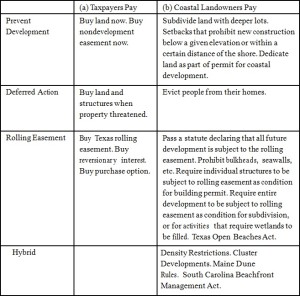It is unlikely that a single policy would be completely effective in managing wetlands in the face of sea level rise. A combination of restoration projects through elevation, and the enabling of wetland migration/ transgression through combinations of setbacks and rolling easements would likely work best for any one level of government, or levels or governments working together. The best policy combination will be dependent on the specific conditions of each locality. Having precise information about what different sea level rise scenarios might do will be critical to the development of effective policy packages.
Table 1, taken from Titus (1998), concisely lists management options for enabling wetland transgression (or inland migration) under conditions of rising sea level. It divides these measures further in terms of who pays—the public or affected landowners.
Preventing development is the most expensive of the “rational” management options. Putting the cost on private landowners where setbacks reduce the economic value of the land will be subject to takings litigation. Restrictions that do not remove all economic use will have a better chance of success. For example, local or state governments could pass density restrictions (under Hybrids in the table) by requiring large lot sizes, or by creating open space endowments by requiring cluster developments. Large lots are more likely to preserve land for inundation, since a property owner is unlikely to bulkhead his entire waterfront boundary. Grouping principal buildings and structures together on a site, or “clustering,” enables developers to reserve land for common open space, conservation, and other purposes. Clustering development and preserving the resulting open space through perpetual easements could preserve critical inundatable lands if the open space easements were placed strategically.
The rolling easement, following the Texas Open Beaches Act, could be a feasible and effective way to ensure the availability of inundatable lands in the future. Buying easements would be a relatively inexpensive way to make the easements more politically palatable and less subject to takings legislation.




